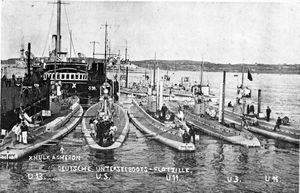Catalogue number 108004
Early German submarines at Kiel, 1914
These early submarines, built between 1909 and 1911, had no deck gun. Shown here at Kiel in 1914, note the high exhaust and air intake tubes.
Recto: "X Hulk Acheron Deutsche Unterseeboots Flottille. U13, U5, U11, U3, U16"
19.5cm x 12.5cm Printed image
|
 |